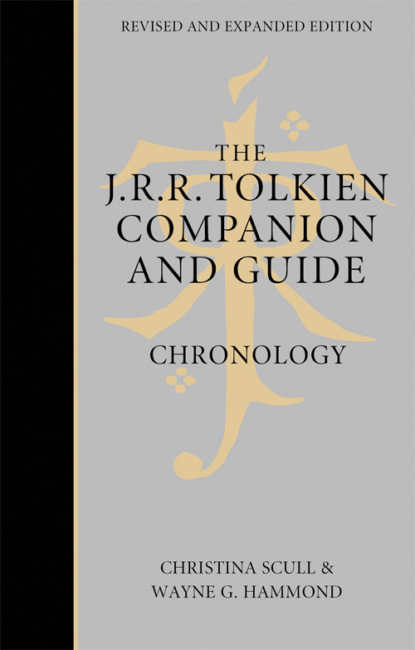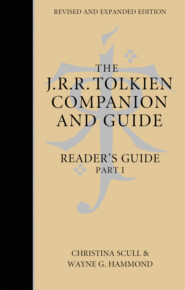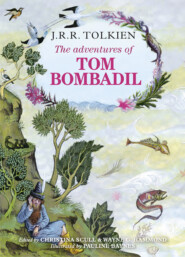По всем вопросам обращайтесь на: info@litportal.ru
(©) 2003-2024.
✖
The J. R. R. Tolkien Companion and Guide: Volume 1: Chronology
Настройки чтения
Размер шрифта
Высота строк
Поля
IN ADDITION to matters with which J.R.R. Tolkien was directly concerned, the Chronology includes selected events from the wider history of the world, as useful points of reference. Subjects marked with an asterisk (*), for the most part only at their first mention, are treated more fully in the Reader’s Guide volumes of the Companion and Guide. Dates are given as precisely as possible, qualified if approximate (c. = circa) or uncertain (?). Here it has seemed appropriate to refer to the young Tolkien as ‘Ronald’ before he went up to Oxford (October 1911), and thereafter usually as ‘Tolkien’. Unless otherwise noted, ‘Gilson’ refers to Robert Q. (Rob) Gilson, ‘Smith’ to Geoffrey Bache (G.B.) Smith, and ‘Wiseman’ to Christopher Wiseman, three of Tolkien’s closest friends during his schooldays and the First World War.
1857 (#ulink_69cd0a61-db38-5d0a-a5b4-48c6e684897e)
18 February 1857 *Arthur Reuel Tolkien, son of John Benjamin and Mary Jane Tolkien (see *Tolkien family), is born in Handsworth, then in Staffordshire, England, near *Birmingham.
1870 (#ulink_72fec586-e677-50c5-b0e0-7f914e48687b)
January 1870 Mabel Suffield (*Mabel Tolkien) is born in Yardley, Warwickshire, to John and Emily Jane Suffield (see *Suffield family).
1888 (#ulink_7d0928fa-ac43-5e71-b8e3-a018b0c1196f)
1888 Arthur Tolkien and Mabel Suffield become engaged, but because of her youth Mabel’s father forbids a formal betrothal for two years. Arthur and Mabel will see each other only at family parties and, with the help of Mabel’s younger sister Emily Jane (*Emily Jane Neave), exchange letters in secret.
1889 (#ulink_3c27f856-c072-51c8-a786-18dbd233d067)
1889 Arthur emigrates to *South Africa to work for the Bank of Africa in the Cape colony.
21 January 1889 Edith Mary Bratt (*Edith Tolkien) is born in Gloucester, England to Frances (‘Fannie’) Bratt of Wolverhampton and Alfred Frederick Warrillow of Handsworth. She will be brought up in that Birmingham suburb together with her cousin *Mary Jane (‘Jennie’) Grove.
13 February 1889 Edith Bratt is baptized in the Wesleyan Methodist chapel in Gloucester. The register records her surname as Bratt, her mother’s name as Fanny, and her father’s name as Frederick.
1890 (#ulink_08ef662d-fc7e-5ab3-883a-0632f74b4ff7)
1890 Arthur is appointed manager of the Bloemfontein (Orange Free State) branch of the Bank of Africa.
1891 (#ulink_b98dc2c2-571a-571f-b8b3-f48faa0876ba)
March 1891 Only a few weeks after her twenty-first birthday, Mabel Suffield travels to South Africa on the ship Roslin Castle. See note.
12 March 1891 Alfred Frederick Warrilow dies. In his will he has named Frances Bratt, ‘Spinster’ and his ‘friend & Housekeeper’, sole executrix as well as his principal beneficiary, leaving her the bulk of his estate ‘including my trade or business of a Paper Dealer’, with a net value of £5,837 4s 8d.
16 April 1891 Arthur Tolkien and Mabel Suffield are married in Cape Town Cathedral.
1892 (#ulink_cbf64d31-afc7-536f-a4c5-efd7a52074e4)
3 January 1892 John Ronald Reuel Tolkien is born to Arthur and Mabel Tolkien at Bank House, Maitland Street, in Bloemfontein.
4 January 1892 Arthur Tolkien writes to his mother that ‘the baby is (of course) lovely. It has beautiful hands and ears (very long fingers) very light hair, “Tolkien” eyes and very distinctly a “Suffield” mouth…. The boy’s first name will be “John” after its grandfather [John Benjamin Tolkien], probably John Ronald Reuel altogether. Mab wants to call it Ronald and I want to keep up John and Reuel …’ (quoted in Biography, p. 12). It was the custom in the Tolkien family for the eldest son of the eldest son to be called ‘John’; ‘Reuel’ apparently was taken from the surname of a family friend (see Letters, pp. 397– 8, and *Names).
31 January 1892 John Ronald Reuel Tolkien is baptized in the Anglican Cathedral, Bloemfontein. See note. His godparents are Mabel’s elder sister, Edith Mary ‘May’ Incledon (see *Incledon family); George Edward Jelf, Assistant Master in St Andrew’s College (diocesan high school for boys), Bloemfontein; and Tom Hadley, the husband of Arthur’s sister Florence.
15 November 1892 Arthur, Mabel, baby Ronald in the arms of his nurse, and two native household servants pose in the garden of Bank House for a photograph, which the Tolkiens send with Christmas greetings to friends and relatives. At some time in 1892 or 1893 the houseboy Isaak, shown in the picture, steals baby Ronald for a time, to show off a white baby at his kraal. Despite the turmoil this causes, Isaak is not dismissed. See note.
1893 (#ulink_a3c72043-e621-5d75-bea1-da0739f2683b)
Autumn (southern hemisphere) 1893 Mabel’s elder sister May and her husband, Walter Incledon, a Birmingham merchant, with their daughter Marjorie, come to Bloemfontein. May and Marjorie stay at Bank House through the southern winter while Walter travels on business.
Summer (southern hemisphere) 1893–1894 Ronald spends the cooler parts of the day in the garden and often watches his father planting vines or trees. One day Ronald is bitten by a tarantula and runs away in terror; his nurse snatches him up and sucks out the poison. In later life he will recall running through the grass, but not the spider itself. – Ronald now shows an interest in drawing, often scribbling with pencil and paper when he visits his father’s offices downstairs in Bank House. But his health suffers in the heat, and he is bothered by teething.
1894 (#ulink_54a9a203-a521-50b2-b554-12398729ac1a)
17 February 1894 Ronald’s younger brother, *Hilary Arthur Reuel Tolkien, is born.
November 1894 Mabel takes her sons on a long train journey to the coast near Cape Town so that Ronald can be in cooler air. He will retain a faint memory of running from the sea to a bathing hut across the sands. On their return to Bloemfontein preparations are made for the family to visit England. Although Arthur is happy in South Africa, Mabel is irritated with Bloemfontein life and dislikes the hot climate, which also poses a risk to Ronald’s health.
Christmas 1894 ‘My first Christmas memory is of blazing sun, drawn curtains and a drooping eucalyptus’ (Tolkien, letter to W.H. Auden, 7 June 1955, Letters, p. 213).
1895 (#ulink_5f640ccb-6aa8-589e-8d9b-4f336de3cce9)
1895 The heat of South Africa having affected Mabel and Ronald so badly, she and Arthur decide that, rather than wait until they can travel together to England on home-leave, she should go on ahead with the boys, and Arthur will join them later, when he feels able to leave the bank.
Late March or early April 1895 Ronald watches his father paint ‘A.R. Tolkien’ on the lid of a cabin trunk.
Beginning of April 1895 Mabel Tolkien, Ronald and Hilary, and the boys’ nurse embark on the steamer Guelph at Cape Town. A comparatively new vessel on the Union Steamship Company’s Southampton-to-South Africa ‘intermediate service’ (that is, designed to transport cargo at an economical speed, as well as passengers), it has a boat deck above the bridge-house
where passengers are allowed to promenade. The ladies’ music saloon is forward, while under it is the first-class dining saloon, arranged for 45 passengers. On the upper deck, ranged along either side of the ship, are the first-class cabins, the smoking-room being aft. The second-class passengers are housed in the poop [raised section at the stern] on the upper deck, with dining saloon and drawing-room, while the steerage passengers are below on the main deck. A special feature is a large dormitory right forward, occupying the full width of the ship, where 64 men can be accommodated, the fare being 10 guineas. [‘Passengers v. Freight Steamships’, Engineering, 12 October 1894, p. 495]
Much later in life, according to The Tolkien Family Album, Tolkien will remember from the long voyage to England ‘two brilliantly sharp images: the first of looking down from the deck of the ship into the clear waters of the Indian Ocean far below, which was full of lithe brown and black bodies diving for coins thrown by the passengers; the second was of pulling into a harbour at sunrise and seeing a great city set on the hillside above, which he realised much later in life must have been Lisbon’ (p. 18). When the family arrive in Southampton three weeks later they are met by Mabel’s sister Jane, and together travel to Birmingham. They stay with Mabel’s parents, Jane, and their brother William at 9 Ashfield Road, Kings Heath (see *Birmingham and environs). Ronald now will also meet his Tolkien relatives and become part of a much larger family circle, although throughout his life he will feel himself more a Suffield than a Tolkien.
Spring–summer 1895 Ronald’s health improves. Arthur Tolkien writes to say that he misses his wife and children, but his departure for England is always delayed.
November 1895 Arthur Tolkien, still in South Africa, becomes ill; some later reports will call his illness rheumatic fever, others typhoid fever. Although he seems to recover, he does not think it wise to undertake the long journey home and then face an English winter.
Christmas 1895 Ronald enjoys his first wintry Christmas with a real Christmas tree.
1896 (#ulink_b6633366-dba0-574e-ba9d-df840afb6ece)
January 1896 Mabel hears that Arthur is still in poor health, and decides that she must return to Bloemfontein to take care of him. She books passage to South Africa for herself and the boys, to leave on 2 March.
14 February 1896 Ronald dictates to his nurse a letter to his father: ‘I am so glad I am coming back to see you it is such a long time since we came away from you…. I am got such a big man now because I have got a man’s coat and a man’s bodice…. Auntie Gracie [Grace Mountain née Tolkien] has been to see us I walk every day and only ride in my mailcart a little bit’ (quoted in Biography, p. 16). On that same day Mabel receives a telegram that Arthur has suffered a severe haemorrhage. Ronald’s letter is never sent.
15 February 1896 Arthur Tolkien dies in the afternoon. See note. The funeral service is held in the Cathedral in Bloemfontein, and he is buried in the Anglican cemetery. Arthur’s estate will bring Mabel an income of only some thirty shillings per week, from shares in South African mines; to this Walter Incledon will add a little. She and the boys are unable to stay in the Suffield house permanently, and in any case Mabel thinks that country air will benefit her sons.
Summer 1896 Mabel Tolkien rents a cottage at 5 Gracewell Road in *Sarehole, a hamlet south of Birmingham. At the impressionable age of four and a half, for the first time Ronald experiences life in a green countryside. He and Hilary explore the surrounding area: Sarehole mill with its water-wheel, meadows, and a tree-lined sandpit; they paddle in the stream; they pick wildflowers and mushrooms and gather blackberries, and are sometimes chased by irate millers or farmers when they trespass. They also climb trees, including a willow which overhangs the mill pond; Ronald will not forget that one day this tree was cut down and simply left lying on the ground. He and Hilary make friends with some of the local children and learn a little of the local dialect, but are sometimes mocked for their middle-class accents, long hair, and pinafores.
1 August 1896 John Benjamin Tolkien dies.
1896–1899 Mabel decides to teach her boys at home. Ronald had already learned to read by the age of four. He now develops a decorative style of handwriting indebted to his mother’s own, and an abiding interest in alphabets and scripts (*Calligraphy). He also begins to learn Latin and German, which he likes, and French which attracts him less. When he shows an aptitude for *languages, and an interest in the sounds, shapes, and meanings of words, his mother also begins to teach him etymology, in which she herself is interested. She tries to teach him to play the piano but has little success. He is more interested in drawing, especially landscapes and trees. He will develop a great interest in botany and come to know the subject well.
The only subject that Mabel does not teach him is geometry; this is taught by his Aunt Jane, Mabel’s sister. Ronald will later say that it was ‘to my mother who taught me (until I obtained a scholarship at the ancient Grammar School in Birmingham) that I owe my tastes for philology, especially of Germanic languages, and for romance’ (Letters, p. 218). He will also remark, of early interests that remained with him through the years: ‘It has always been with me: the sensibility to linguistic pattern which affects me emotionally like colour or music; and the passionate love of growing things; and the deep response to legends (for lack of a better word) that have what I would call the North-western temper and temperature’ (letter to W.H. Auden, 7 June 1955, Letters, p. 212).
It is probably in this period that Mabel takes the boys on at least one seaside holiday, and Ronald begins his first sketchbook: near the beginning is a childish drawing, Sea Weeds and Star Fishes (Life and Legend, pp. 12–13). – At this time Mabel is still a practising Anglican. Since her husband’s death, she has taken her sons with her every Sunday to a ‘high’ Anglican Church.
Ronald’s early reading includes the Alice books by Lewis Carroll, which amuse him; The Princess and the Goblin and The Princess and Curdie by *George MacDonald; the fairy books of *Andrew Lang, in particular ‘The Story of Sigurd’ in The Red Fairy Book which fires his interest in *dragons; and Stories for my Children by E.H. Knatchbull-Hugessen, especially the tale of ‘Puss Cat Mew’ (*Fairy-stories). He also likes Red Indian tales and Arthurian legends (*Arthur and the Matter of Britain). In later life, he will note that he did not enjoy Treasure Island by Robert Louis Stevenson, the stories of Hans Christian Andersen, or The Pied Piper by Robert Browning; and that while he read fairy-stories he did not develop a real taste for and appreciation of them until he was about eight. Nor was it until he began to study Latin and Greek at school that he developed any appreciation of *poetry. Even in early childhood his interests are more factual or scientific (*Science): history, astronomy, natural history (especially botany and zoology), palaeontology (he liked pictures of prehistoric animals), geology, grammar, and etymology. He will note several times that he was not particularly interested in or proficient at mathematics.
1896–1900 Much later, Tolkien will write to a group of primary school children in *Acocks Green, some two miles north-east of Sarehole: ‘I lived till I was 8 at Sarehole and used to walk to A[cocks] G[reen] to see my uncle. It was all “country” then …’ (17 October 1966, quoted in Sotheby’s, English Literature, History, Children’s Books and Illustrations, London, 16 December 2004, p. 274).
1897 (#ulink_6604c32a-583a-55f6-9674-bc6f9209c55b)








